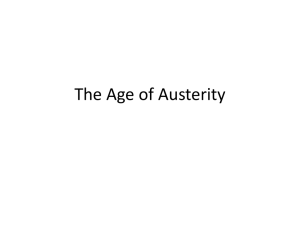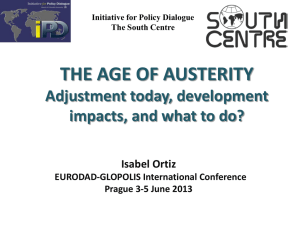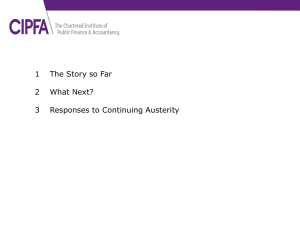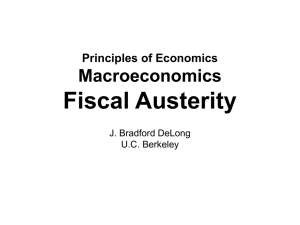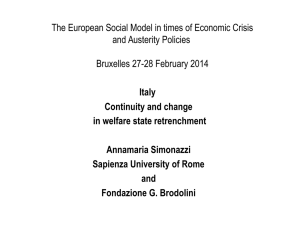Microsoft Word - DORAS
advertisement
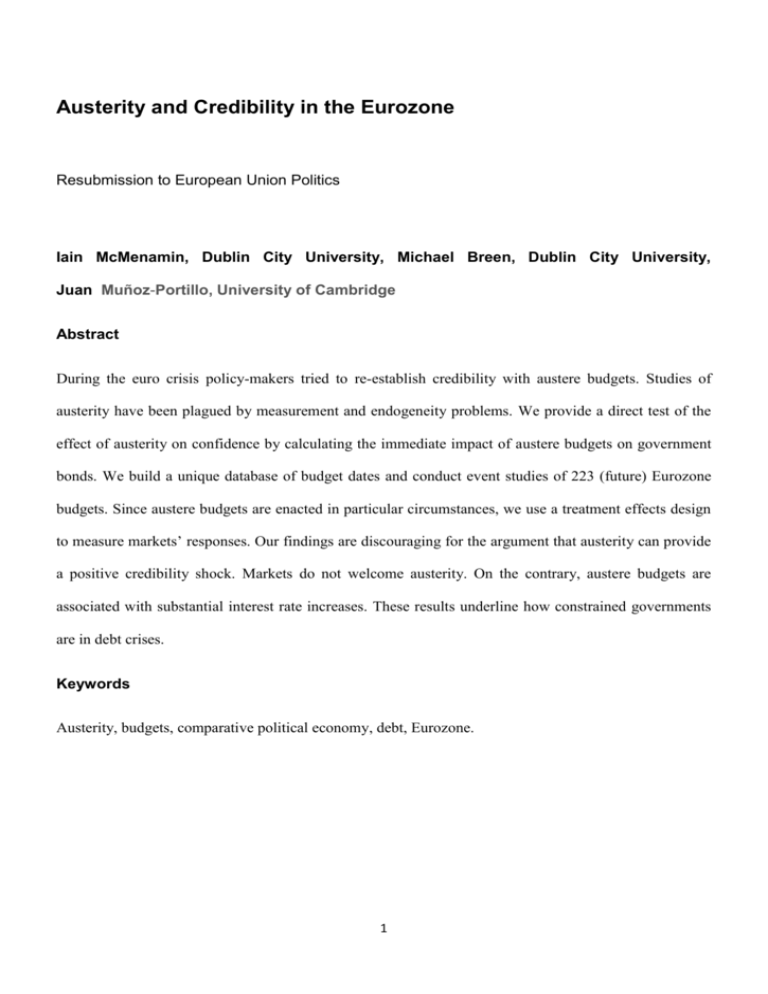
Austerity and Credibility in the Eurozone Resubmission to European Union Politics Iain McMenamin, Dublin City University, Michael Breen, Dublin City University, Juan Muñoz-Portillo, University of Cambridge Abstract During the euro crisis policy-makers tried to re-establish credibility with austere budgets. Studies of austerity have been plagued by measurement and endogeneity problems. We provide a direct test of the effect of austerity on confidence by calculating the immediate impact of austere budgets on government bonds. We build a unique database of budget dates and conduct event studies of 223 (future) Eurozone budgets. Since austere budgets are enacted in particular circumstances, we use a treatment effects design to measure markets’ responses. Our findings are discouraging for the argument that austerity can provide a positive credibility shock. Markets do not welcome austerity. On the contrary, austere budgets are associated with substantial interest rate increases. These results underline how constrained governments are in debt crises. Keywords Austerity, budgets, comparative political economy, debt, Eurozone. 1 Europe’s debt crisis was in large part a credibility crisis. Indeed, as many have pointed out, the Eurozone’s debt statistics compared quite well to the UK and the US (Wolf, 2012). However, investors doubted whether the Eurozone was committed to paying its debts. Ultimately, Mario Draghi’s promise to ‘do whatever it takes to save the euro’ convinced markets that, like the US and UK, the Eurozone’s debts were ultimately guaranteed by the central bank. Until Draghi’s intervention the onus was on governments, whether as individual debtors or collectively as members of a currency zone, to demonstrate that they would and could honour their bonds. Credibility, like so much in social and political life, is subject to virtuous and vicious circles. A more credible government receives a lower interest rate, which in turn increases its credibility further. A government that loses credibility will pay higher interest rates and may suddenly find itself in a debt crisis, in spite of little or no deterioration in its fiscal situation. This is a plausible interpretation of Italy during the crisis. The most obvious way to break out of a vicious circle of declining credibility is to make a dramatic intervention, to try to administer a credibility shock. In a debt crisis, the annual budget is a particularly appropriate opportunity to reestablish credibility. This was the official theory of the Eurozone during the crisis (Blyth, 2013: 61, 17576). For example, Olli Rehn, the Commissioner responsible for Economic and Monetary Affairs, commented that an Irish budget at the height of the crisis could ‘enhanc[e the] credibility of fiscal policy[’s] positive impact by front-loading budget measures,’ even if these measures had a short-term negative impact on growth (Irish Examiner, 2010). Indeed, it is not too hard to find anecdotal evidence of markets welcoming austerity (House and Román, 2012; Telegraph, 2010). Ulster Bank reported that market reaction matched Rehn’s prediction in the aftermath of the Irish budget of 2010: [T]he Government is beginning to see some payback from the international debt markets for its efforts, as its cost of borrowing has declined since the Budget … The spread on Irish government bonds relative to Germany has narrowed in by almost 40 basis points (0.40%) since the evening of the Budget (Barry, 2010). The theory of ‘expansionary fiscal consolidation’ argues that, despite an immediate reduction in demand, an increase in confidence that the government can control its debt will eventually lead to increased economic growth and lower debt. We do not enter this politically and academically fraught 2 debate (Blyth, 2013: 132-143; Herndon et al., 2013; Krugman, 2013; Reinhart and Rogoff, 2010; Reinhart et al., 2012; Stuckler and Basu, 2013). Instead, we investigate whether austere budget announcements can administer an immediate credibility shock. Arguably, this was more important to the Eurozone during the crisis than an eventual impact on the real economy. Between 2010 and 2012, the Eurozone focused on survival from day to day rather than longer term prosperity. The key statistic was tomorrow’s interest rate, not economic growth in three years’ time. We test the effect of austere budgets on the credibility of sovereign debtors. To do so, we collect a unique set of budget days for Eurozone countries and then conduct a series of event studies to calculate how bond markets reacted to each budget. Since austere budgets tend to be enacted in particular circumstances, we use a second quasiexperimental technique – a treatment effects model to measure the effect of austerity on the interest rate. We argue that budget days should be theoretically informative according to the efficient market hypothesis and show how political economy hypotheses can serve as a guide to when austerity should be unexpected. Austerity and Credibility The efficient market hypothesis (EMH) states that markets should immediately and rationally react to new information relevant to asset prices (Fama, 1970). This is a sharp hypothesis that rules out psychological biases that would cause, for example, overreaction or under-reaction to new information (De Bondt and Thaler, 1985). Nevertheless, the EMH does not specify which information is relevant and the direction of its effects. There are several views on how markets might react to political information. One is that politics does not matter. Mosley (2001) argued that markets only react to macroeconomic variables when assessing asset prices in developed markets. By contrast, she finds that political factors often have an impact in emerging markets. Bernhard and Leblang (2006) find many effects of elections and government formation in developed markets. These different results do not necessarily reflect a profound disagreement. Mosley’s emphasis and her methodology are relatively long-term and macroeconomic, while Bernhard and Leblang’s emphasis and methodology are short-term and financial. 3 The case of the national budget is potentially very enlightening for this literature, since it is a political event focused on macroeconomic policy. Efficient markets ‘price in’ the probability of relevant developments. If traders are sure that an event will happen, for example that a particular party will win an election, then no impact will be observable around the date of the election itself. The combination of efficient markets and gradual information release makes it difficult to estimate the impact of events. Nonetheless, ‘pricing in’ is a revision of a probability estimate and this should always be less than one until the event itself has happened. Indeed, if markets really do process information rationally they should attach probabilities of much less than one to any predictions on which they base their investments. Thus, even if an event is anticipated, some impact should be observable. Variations in the predictability of events, or the gradualness of information release, can bias event studies (Campbell et al., 1997: 174). There are substantial variations in the extent to which budget proposals reveal unexpected information, but we argue that these are systematically related to political institutions, for which we control in some of our models. When there are many veto players, the budget tends to be process of relatively public negotiation, from which information is released gradually. When there are few veto players, the budget is an announcement of decisions made privately. A separate issue is the transparency and accuracy of public finance statistics. In transparent systems, a budget signals policy intention but little new fiscal or macroeconomic information. In opaque systems, the fiscal impulse might be an indicator of the underlying fiscal situation. Where transparency is lacking, austerity might indicate to investors that the fiscal situation is worse than the government had previously suggested.1 Therefore, we test whether the effect of budget announcements decreases conditional on the number of veto players and the level of fiscal transparency. 1 We owe this idea to an anonymous referee. 4 Unsurprisingly, it is less than straightforward to relate much political information to asset prices. Indeed, some interesting research uses political uncertainty to predict asset price volatility. The related phenomena of uncertainty and volatility are often associated with unusual political events and institutional change, such as Goldbach and Fahrholz’s (2011) work on the Stability and Growth Pact or the work of Phillips (2014) on reform in Latin America. Budgets, by contrast, are annual and universal. Indeed, if only one figure is used to summarize a budget, there is a consensus on what that figure should be: the fiscal impulse dominates media reports of budgets, perhaps especially in the financial press. This is also the focus of our research. Nonetheless, a minority of budgets are undoubtedly characterised by uncertainty and volatility. The emergency budgets we have excluded from our analysis perhaps fall into this category. Statistically, level effects and volatility are clearly distinguishable. Economically, they tend to be linked: uncertainty is bad for investment. Alberto Alesina has been the principal advocate of austere fiscal policy. He does not deny that government retrenchment reduces demand in the short-term (Alesina and Ardagna, 2012: 3). In the medium-term, by contrast, he claims that fiscal corrections can reduce debt and increase growth, partly through a ‘confidence’ or ‘expectations channel’ (Alesina, 2012: 434; Alesina and Ardagna, 2012: 9). Austere budgets should reassure investors of the stability of government finances and increase opportunities for the private sector. Alesina’s confidence channel is consistent with a class of signalling models in which a ‘tough’ policymaker seeks to demonstrate his true type. If market actors receive this signal they will infer credible commitment and reduce the interest rate (Drazen, 2000: 197-92). Although Krugman has famously derided the ‘confidence fairy’ (Krugman, 2010), much of the analysis has centred on trying to unravel the causal relationship between fiscal policy and macroeconomic outcomes. In essence, the theory of expansionary fiscal contraction suggests that markets should welcome austere budget proposals. 5 We see two reasons why markets might react in the opposite way. First, like Krugman and the Keynesians, investors might well doubt the existence of the confidence fairy, and view austerity as deepening a spiral of declining demand in the economy. A vicious circle of recession is obviously bad for their investments. The other explanation accepts the importance of a confidence channel but derives the opposite prediction. Sargent and Wallace (1981: 5-6) argued that ‘tight’ monetary policy can have the opposite effect from what one would naively expect due to today’s policy affecting the trade-off the policymaker faces tomorrow. The expectation of monetary growth tomorrow induces an increase rather than a fall in inflation today. This argument is echoed by a feature of the ‘second generation’ of models of currency crises. The more extreme the measures a government takes to defend a policy commitment, the more likely it is that they will have to abandon that commitment (Drazen and Masson, 1994), with Britain’s failed defence of its membership of the European Monetary System being a celebrated case. Analogously, the announcement of an austere budget today generates an expectation that the government will have to expand the economy tomorrow, so interest rates rise rather than fall in response to austere budgets. The most obvious driver here is a limit on acceptable levels and increases in unemployment. This is a separate mechanism to the effect of austerity on electoral behaviour. A government responsible for austere budgets might be less likely to be re-elected and therefore the policy is likely to be reversed. We test for the difference between the Keynesian and confidence arguments by including lags of budgetary policy. A plethora of political economy models are relevant to these arguments. Electoral cycle, partisan, and institutional context should condition markets’ expectations about austerity. These are derived from a literature that tends to focus on macroeconomic outcomes, but should also apply to financial markets. Indeed, since some of the arguments emphasise expectations they fit in nicely with a study of market reaction to political information. Moreover, the macroeconomic predictions of many of these models are based on the very questionable assumption that the government controls monetary policy, an assumption 6 that is obviously even more misleading in the context of EMU. Thus, fiscal applications have the advantage that the policy is actually under the control of the policy-makers that are being modelled. According to the Political Business Cycle, politicians should inflate the economy before elections to win votes (Tufte, 1978). Therefore, austerity should not be expected before elections and should be a welcome surprise for markets. Rogoff and Sibert’s (1988) signalling model of policymaker competence generates the same prediction. It is a sort of brinkmanship in which the policymaker generates a difficult situation, signalling that he is more competent than his competitors to deal with the economy after the election. The partisan model of Hibbs (1977) states that the left should have a preference for relatively low unemployment and relatively high inflation. Austere budgets under the left should thus be more surprising. Alesina (1987) extends the partisan model to take in expectations, which amount to pricing in of partisan preferences. Therefore, an austere budget by an incoming left-wing government should be surprising and should reduce interest rates. After the first budget, the markets revise their expectations of the government and there is no longer a partisan effect. The contingent partisan model of Hibbs (1994) generates the same prediction. Markets’ reaction to a given policy commitment will depend on the institutional context in which it is made. Fiscal policy is very much subject to time consistency problems (Kydland and Prescott, 1977). At time point one the government chooses retrenchment as an optimal policy because interest rates are too high; at time point two investors buy more of the government’s debt; at time point three, due to the better interest rate, the government chooses a fiscal expansion as the optimal policy. Investors are aware of the government’s time-inconsistent incentives and therefore do not reduce interest rates when austerity is announced at time point one. However, institutions can modify policymakers’ incentives, making it more difficult to renege on commitments. One approach looks to the overall structure of the political system, in terms of relevant political actors or veto players (Breen and McMenamin, 2013). The greater the number 7 of veto players, the more difficult it is to reverse decisions, and therefore, the more credible are the government’s commitments. The theory of credible commitment has perhaps been most studied, and most applied, in the area of central banking. Unfortunately, the available data does not allow us to test for how variations in the independence of central banks might condition bond market reactions to Eurozone budgets. The fiscal governance approach focuses on specific budgetary procedures. Theoretically, it is anchored in the common pool resource problem (Elgie and McMenamin, 2008). In the absence of a central co-ordinator, spending ministers are like pastoral farmers overgrazing a commons; they seek to maximise their individual political benefit by claiming credit for popular spending programmes, while externalizing the cost to the government as a whole. Thus, whereas the credible commitments paradigm concentrates on optimal policy-making for each time point, the common pool problem predicts suboptimal fiscal policy making. Hallerberg et al. (2009) have argued that different methods of co-ordination are congruent with certain configurations of the overall political system. A contract type of fiscal governance suits systems with lots of veto players, in which coalition partners agree to a fiscal plan that lasts for a governmental term, not just a year. Delegation suits systems with fewer veto players and, in particular, single-party governments. In such systems, there are no competing players to enforce contracts. Delegation to a finance minister allows party ministers to take into account the costs of budget deficits on the economy and can assist a party in successful fiscal management over a term. Thus, although market expectations are not a central feature of the fiscal governance theory, variations in fiscal institutions should condition the effect of announced policies. Markets should welcome austere budget announcements conditional on appropriate fiscal governance institutions. 8 Methodology The two principal obstacles to the calculation of the effects of fiscal policy are measurement and endogeneity (Alesina, 2013: 430-431). The usual approach has been to use the budget deficit or surplus as an indicator of policy. Unfortunately, this measure conflates intention and outcome. Even cyclicallyadjusted fiscal data cannot fully resolve this problem. Recently, many scholars, notably at the IMF, have turned towards a narrative approach (Devries et al., 2011). Using official documents it is possible to identify the scale of intended retrenchment or expansion. Another fundamental problem is that GDP growth and budgetary policy are endogenous. Even with a good measure of policy intention, it is very difficult to identify the extent to which policy is a cause or an effect of economic performance. We avoid both these problems by first conducting an event study to estimate market reactions to a given budget and secondly using the estimated market reaction as a dependent variable in treatment effects regression, wherein austerity is the treatment. In doing so, and in contrast to previous work (Ardagna, 2004), we also provide a relatively direct test of the confidence argument. We estimate the impact of budgets on bond yields using the classic, or finance, event-study methodology (Corrado, 2011: 220; Sandler and Sandler, 2012: 3). We do not measure simple changes in yields before and after budgets. Instead, the essence of this technique is to posit the counterfactual: the yield of the bond if the budget had not happened. In event studies, this is known as the normal return. The abnormal return, then, is the difference between the actual yield and the normal return (Campbell et al., 1997: 151). We establish a normal return by regressing the yield of the bond in question on the yield for German bonds. Germany’s bond is generally the most liquid and the safest sovereign bond. Some event studies use more variables to predict the normal return (Bechtel and Schneider, 2010). However, Campbell et al. observe that extra factors tend to add little to the model’s predictive performance. The period for which we regress the bond of interest on its German counterpart is called the estimation window. For each budget in our dataset, the estimation window consists of the period between one month 9 and six months before the budget. This amounts to 99 trading days in most cases.2 We exclude the last month before the budget to reduce contamination from pre-budget speculation. Since it takes markets some time to assimilate new information, we specify an event window of five days after the budget is proposed. We then cumulate the abnormal returns over these five days to give us the cumulative abnormal return (CAR), which in this article, as in the majority of event studies, serves as our dependent variable. There are several event studies of elections (Bernhard and Leblang, 2006; Sattler, 2013) and of other political events such as summits (Goldbach, and Fahrholz, 2011; Smeets and Zimmermann, 2013). However, this is the first event study of budgets. We estimate the CAR using daily yields on ten-year benchmark bonds from Datastream, which for most rich countries date back to the 1990s and 1980s (Kuttner and Posen, 2010: 360). Benchmark bonds are the latest issue, so there is no problem with time to maturity. Many studies use credit default swaps as a cleaner measure of risk. Unfortunately, they are a relatively recent innovation and we can extend the sample and leverage more political and economic variation using the interest rate. For some countries, we lengthen the time series somewhat by using another long-term bond that we can show correlates at over 0.97 with the benchmark bond. Due to constraints on the availability of a time series of benchmark bonds and IMF data on fiscal policy, our sample consists of Austria, Belgium, Finland, France, Greece, Ireland, Italy, the Netherlands, Portugal, and Spain. Germany is excluded because it provides the benchmark for our estimation equations. We avoid extending the analysis beyond the eurozone because the German bond is not a good predictor for their interest rates and because variations in currency exchange and monetary policy regimes make comparisons difficult. The sample begins in 1987 but the start date is later for many countries, the last of which is Greece in 1999. Our models include up to 210 observations, since we lose some observations due to listwise deletion in our regressions. Concentrating on the Eurozone has an important analytic advantage. Monetary policy was completely delegated to the European Central Bank (ECB) in 1999. Before 1999 monetary policy was co-ordinated by the ECB’s precursor, the European Monetary Institute. Even prior to the Maastricht Treaty of 1992, there was substantial monetary 2 However, Greek interest rates in 2011 and 2012 were so volatile that we use a shorter estimation window beginning twentyone and ending two days before the budget. 10 co-operation. Moreover, Germany’s Bundesbank had become the de facto monetary authority for European countries, albeit to varying extents. Therefore, our sample is one in which fiscal policy should have been relatively more important than in countries that had much more influential national central banks. Some budget dates are more obvious than others. In Westminster countries, the budget day is highly theatrical and is one of the highlights of the parliamentary calendar. In Britain, for example, the Chancellor of the Exchequer poses with his briefcase before he presents the budget. In most consensual countries, there is no such focus on a single day. Indeed, key dates are often spread out over three months from the presentation of the government’s budget proposal to the eventual passing of a budget by parliament. In such countries, the budget is more a process than an event. There are exceptions of course. In the consensual Netherlands, the government presents its budget on the day of the annual opening of parliament amongst as much ceremony as its British equivalent. In majoritarian Spain, the ‘budget day’ is a press conference on the steps of the parliament. Despite these differences, in all representative democracies the executive proposes a budget, which must be approved by parliament. We have chosen the day that the government makes its formal budget proposal to parliament as the budget date. This event occurs everywhere and has the most potential to reveal information to the market. The passing of the budget also happens everywhere but is less likely to convey new information to markets. It is increasingly common for governments to present fiscal targets and assumptions before the budget itself. However, this practice is far from universal and is too hard to identify. We only include the annual budget, not supplementary or emergency budgets. While the latter often have a great effect on markets, they are too likely to be endogenous. While we have not gathered data, our impression is that emergency budgets are often reactions to drastic increases in the interest rate on public debt. We identified most budget dates using reports on Lexis-Nexis and official documents.3 Figure 1 presents the distribution of budgets in a calendar year. The autumn is the most popular time for a budget because, in most countries, the fiscal and calendar years are identical. 3 The dates and documents can be found at http://webpages.dcu.ie/~mcmenami. 11 [Figure 1 about here] We establish a highly credible normal return, compared to the minority of event studies that report the relevant statistics (Demir and Danis 2011; Geranio and Zanotti 2010; Gilligan and Krehbiel 1988; Kuttner and Posen 2010; Roberts 1990). For example, our average R-squared of 0.73 is more than four times that of Jayachandran’s (2006) study of political donations and the US stock market. The next step is to explain variation in the impact of budgets. We test for the impact of austerity using a treatment-effects design. Clearly, austerity is not a random treatment and can be predicted with a range of macroeconomic variables (Jordà and Taylor, 2013: 3). Our treatment effects model consists of two equations. The first is a probit model to estimate the likelihood of austerity. The estimates from the probit then re-weight the sample for the second stage, which tests for the impact of austere budgets on bond markets. Since the samples of austere and non-austere budgets now resemble each other, we obtain a much more accurate estimate of the causal impact of austerity. Moreover, the error terms in the first and second equations are highly correlated (see LR ρ=0 in Table 2), indicating that our choice of model is valid and that we would not arrive at the same conclusions if we were to ignore the first stage. When the same variables affect both treatment and outcome variables, it is possible to use methods like propensity-score matching, inverse probability weighting, and nearest-neighbour matching. However, in our case it is recommended that we use a more basic model – linear regression with endogenous treatment effects (Greene, 2012: 890-894; Wooldridge 2010).4 This is because the variables that explain our binary measure of fiscal policy are poor predictors of market returns, since they tend not to vary over the event window. The regression equation is CAR j x j Austerity j j , for a budget announcement j where x j are the covariates that model our outcome variable and Austerity j is a binarytreatment variable where Austerity j 1 if w j j > 0, (otherwise = 0). In this equation, w j is a vector of the determinants of consolidation following Jordà and Taylor’s (2013) recent work. Across equations, 4 The treatreg command in STATA 12. 12 the errors j and j are assumed to be bivariate normal with mean zero and the covariance matrix is defined as 2 . 1 Most studies of fiscal policy use the budget deficit as a measure of fiscal policy, when it is of course an outcome of policy and a range of factors that the political system struggles to control. Instead, we employ the IMF’s dataset of action-based consolidation (Ağca and Igan, 2013; Devries at al., 2011), which measures policy rather than outcome. It builds on the methodology of estimates of the fiscal policy in the United States (Romer and Romer, 2010). The historical sources they examine include Budget Reports, Budget Speeches, central bank reports, Convergence and Stability Programs submitted by the authorities to the European Commission, IMF reports and OECD Economic Surveys. In addition, they examine country-specific sources, the Journal Officiel de la République Française for France, Ministry of Finance press releases and publications. We have replicated the IMF analysis for observations. Since the fiscal impulse is the headline news for all analyses of budgets, it is almost always straightforward to identify it. Each observation of austerity is accompanied by a narrative and citations in the IMF papers cited above. The IMF has adjusted its data so that it refers to the calendar year for all countries in the dataset. For those states in which the calendar and fiscal years do not coincide we have replaced the IMF’s number with the relevant number for the fiscal year, as this is clearly the period on which markets will focus in the aftermath of the budget. We have updated the dataset for a handful of recent years and for Greece. In addition, we have taken care to match the IMF’s data to the correct budget. Usually, but not always, the fiscal policy for fiscal year t is announced in calendar year t-1. The austerity variable enters our equations as a dummy, partly because we adopt a treatment effects framework. We list the country-years of austerity in the online appendix.5 We measure veto players using the political constraints index, which estimates the feasibility of policy change on the basis of whether branches of government have vetoes, whether they are controlled by different parties, and the level of heterogeneity of political preferences within branches of government 5 The whole dataset can be downloaded from http://webpages.dcu.ie/~mcmenami. 13 (Henisz, 2004: 363). For fiscal transparency we rely on Alt et al. (forthcoming). They combine several separately coded measures of the transparency of budgetary institutions and impute some missing observations. To evaluate partisanship, we take estimates of parties’ ideological positions from the Comparative Manifesto Project. The scores of all parties are calculated by subtracting the percentage of the manifesto coded as right-wing in emphasis from the percentage coded as left-wing and are measured at each election (Budge et al., 2001: 21). We then derive a measure of government ideology by summing the positions of all parties and weighting them by their cabinet seat share (Kim and Fording, 2001: 166). We have adjusted the CMP’s annual scores to match our budget dates. For fiscal governance, we were provided with the contract and delegation indexes by Mark Hallerberg, the construction of which is described in various publications (Hallerberg et al., 2009). To test for the congruence of fiscal institutions, we need a measure of polarization. We use a variable from the World Bank’s Database of Political Institutions (DPI). The DPI includes the economic orientation of the four largest parties and the executive in each country, coded as left, centre, or right. Pairwise comparisons of economic orientation are made; the difference in economic orientation between the pair of veto players exhibiting the largest difference in orientation is the political polarization measure (Keefer and Stasavage 2003). The sources for all variables are listed in the online appendix. Analysis Figure 2 plots the evolution of cumulative abnormal returns over time. Positive figures indicated that the bond market reacted sceptically to a budget and increased the interest rate. Negative figures, by contrast, suggest that markets welcomed the budget and reduced the interest payable on a government’s long-term debt. The crisis era does not exhibit an extreme pattern. The euro’s early honeymoon years appear exceptional in our quarter-of-a-century time period. During these years there was little appreciable reaction to budgets. Prior to the euro and since the crisis the wide range of impacts suggests that there is substantial potential for budgets to bolster or undermine the credibility of sovereign debtors. It is important to note that while the figures for these two periods are similar, they represent different 14 processes. Prior to the euro, bond investors worried about devaluation. The large CARs in the early 1990s represent worries about countries not being able to maintain the relative values of their currencies in the European Monetary System. By contrast, during the sovereign debt crisis from 2010 investors worried about default rather than devaluation. Fiscal policy has a much more direct link with default risk and is secondary to monetary policy for devaluation risk.6 [Figure 2 about here] The budget announcements of Portugal, Italy, Ireland, Greece, and Spain (commonly known as the PIIGS and less commonly as the GIIPS) feature many of the largest reactions to austerity and non-austerity budgets. For example, in 2012, markets welcomed austerity across the PIIGS. Similarly, there were large positive reactions to Ireland’s budgets in 1987 and 1988, and Spain’s in 1994 and 1996. At other times, however, markets have welcomed the PIIG’s non-austere budgets. More specifically, there were positive reactions to Portugal’s non-austere budgets in 1996 and 1997, and Ireland’s in 1990 and 1993. At the other extreme of our dependent variable, markets have sometimes reacted badly to the PIIGS’ budgets. There were highly negative reactions to Greece’s austerity budgets in 2010 and 2011, Ireland’s in 2008 and 2010, Spain’s and Italy’s in 1992, and Portugal’s in 2010. On the other hand, there also negative reactions to Italy’s non-austere budgets in 1989 and 2008 and Spain’s in 1993 and 2008. Many of these cases are anything but typical. Since our goal is to estimate the typical effect of austerity we must consider the specific circumstances that lead countries to consider austerity. Without controlling for these circumstances, we are likely to miss the effect of austerity on credibility. Table 1 shows some descriptive statistics. It is designed to investigate the impact of extreme Greek observations and as a preliminary exploration of the impact of austerity. We think that the Greek observations of 2011 and 2012 are extreme and unreliable. These two budgets occupy the minimum and the maximum and increase the range by a factor of over 4.5. Moreover, including these observations changes the sign on the mean for the overall sample and for austerity during the crisis. Even though we used a shorter estimation window to try to accommodate the extreme volatility of Greek interest rates 6 The importance of this distinction was emphasised by an anonymous referee. 15 during the crisis, the CARs are worryingly large. However, Greek budgets from 1999 to 2010 have CARs within the range of the other countries using the normal estimation window. Where possible we will include the pre-2011 Greek observations in our regression. These descriptive statistics tend to undermine the idea that austere budgets bolster credibility in the bond market. The austerity CAR is larger than the CAR for non-austere budgets in the population, in the population excluding Greece, and in the crisis period. However, if we limit our analysis to the seventeen non-Greek budgets during the crisis, austere budgets have an advantage. As we have already explained, austerity is not randomly assigned. Therefore, we now move on to calculate the average treatment effect of an austere budget on borrowing costs for the Eurozone. Table 1 presents our basic results. The first stage replicates Jordà and Taylor’s (2013: 22) ‘saturated model’ for predicting austerity. This model is motivated statistically by a concern to control for the probability of treatment assignment, not by an aspiration to provide a theoretical explanation of the decision to adopt austere budgets (hence, for example, the inclusion of variables like the short-term interest rate). Our results are very much consistent with theirs and increase our confidence that we will have a good estimate of the treatment effect in the second stage. The sign and magnitudes of the austerity coefficients in the second stage indicate the net impact of austerity on interest rates, other things being equal. In all models, the coefficients are positive and statistically significant. This means that, on average, bond markets have reacted to austerity by increasing interest rates. The immediate effect of austere budgets is to reduce confidence in government bonds. Bond markets appear to be sceptical about the efficacy of austerity. [Table 1 about here] We proceed to examine more detailed arguments about the conditions under which markets react to budgets. The treatment effects design is very demanding on degrees of freedom and we were unable to 16 consistently fit the saturated model when adding variables and varying the sample. Instead, we employ Jordà and Taylor’s base model at the first stage, which includes the one-year lags of gross general government debt, GDP (Hodrick–Prescott time-series filter), GDP growth, and fiscal consolidation. This model produces very similar results to its saturated equivalent. In the remaining tables, we only report the second stage, which is the focus of our theoretical and substantive interest. All the models include country fixed effects at the first stage. In order to study austerity as a treatment, we need to dichotomize the IMF data. Clearly, the threshold might matter. We have adopted the most logical threshold: fiscal expansion versus contraction. Nonetheless, there is a theoretical reason to think that this threshold might drive misleading results. Markets might expect greater fiscal contractions.7 In other words, the increases in interest rates could be interpreted, not as disappointment with an austere budget, but disappointment that the budget was insufficiently austere. Therefore, we re-test using two higher thresholds: contractions of one and one and a half per cent of GDP. Models 1 and 2 in Table 2 reject the idea that markets perceive a need for more severe austerity. The coefficients on the austerity treatment continue to be positive. Indeed, the coefficients are larger than for the simple zero threshold. [Table 2 about here] Notwithstanding plans for economic and monetary union and Deutschmark dominance, the pre-euro and post-euro environments are fundamentally different. In the pre-euro period, fiscal policy could be complemented or replaced with devaluation and central bank intervention. Moreover, national bonds were associated with a national inflation risk. In the euro period, monetary policy had been delegated to the supra-national European Central Bank. Therefore, even though some have argued that the euro era was unlikely to herald a different level of financial market pressure (Mosley 2004), there are good reasons to expect a rather different relationship. We conducted separate regressions for these two eras, shown in models 3 and 4 of Table 2. If we look at the euro-era prior to 2010 (model 5) the austerity coefficient loses statistical significance. This quiescent period is the only time we do not observe 7 We owe this idea to an anonymous referee. 17 austerity increasing interest rates. Clearly, there are too few crisis observations to draw very strong conclusions. Nonetheless, the contrast between models 4 and 5 suggests that markets were even less impressed with austerity in the recent crisis than in the previous twenty-three years. We carefully tested a range of political economy models discussed above. These include political institutions, partisan effects, and budgetary transparency. None of these modified the basic result for austerity; neither did they provide any support for the theories in question. The output is presented in the online appendix. We did, however, find some weak evidence in favour of effects consistent with the fiscal governance approach, shown in models 6 to 8 of Table 2. The arguments of this literature are difficult to test because they postulate several complex interactions, which are very demanding on data. We tested all relevant interactions individually and in permutations. We present the simplest version in model 6, which is theoretically too simple but is testable using our data. Model 7 tests the contract form of fiscal governance against its hierarchical equivalent and model 8 seeks to mobilise the full fiscal governance argument, while acknowledging that we do not have the data to test it convincingly. There is evidence in each of the three models that austere budgets in contract systems are less damaging to market confidence or indeed actually reduce interest rates. For example, the predictions of model 6 suggest that the increase in interest rates associated with an austere budget in a country with a score of one standard deviation below the mean for the contracts index is about twice that of an austere budget proposal in a system that is one standard deviation above the mean. Like delegation systems, contractual arrangements for fiscal governance can mitigate the common pool problem. Moreover, they should have more time consistent incentives than delegation systems, since it is harder to reverse policy. There is not enough variation in the fiscal governance data. Effectively, it is measured at only two time points. Therefore, it is possible that better data might strengthen this result. Our interpretation of all these results is straightforward: markets do not buy the economic theory behind austerity. We tested for a more subtle interpretation in which a record of austerity leads markets to anticipate that governments will eventually be forced into fiscal expansion. See the online appendix, 18 wherein we report a model in which a lag of austerity and its interaction were insignificant and did not change the basic result. Finally, we conducted a number of tests for robustness to statistical issues, which can also be found in the online appendix. Our event window of the week after the budget is reasonable but arbitrary. We also tested for the effect of event windows from six to forty trading days after the election. Figure A1 suggests that bond markets’ aversion to austerity is not fleeting. Our conclusions are not an artefact of the chosen event window. Budgets tend to cluster in September and October. Therefore, it is possible that crosscorrelation between the budgets of different eurozone members is affecting our results. Kolari and Pynnönen (2010) developed a T-test for the null hypothesis that there is no cross-sectional correlation in the CAR. Essentially, this works by standardizing the CAR according to the sample cross-correlation of abnormal returns in the estimation window. We excluded all observations that failed to reach the one per cent level of statistical significance for the Kolari and Pynnönen test. In the resulting sample of 187 budgets, shown in model 7 of the online appendix, austerity continues to be statistically significant associated with a rise in interest rates. While the average R-squared of the estimation equations for the CAR is more than satisfactory, the standard error of the CAR, our estimated dependent variable, varies across our observations. We used FGLS to weight our observations by the inverse of the standard error from the estimating equation for the CAR (Lewis and Linzer 2005) in models 8 and 9 of the online appendix.8 Again, there is little change in our results. Conclusions The euro crisis featured many controversial policy debates. One of the most bitter, and most technical, was the debate about fiscal policy. Austerity has become one of the most politically-charged words in the European political lexicon. EU policymakers did not generally advocate austerity as a ‘good housekeeping’ policy that would realign income and expenditure. Instead, they perceived Europe’s debt 8 The edvreg user-written command in STATA 12. 19 crisis as very much a credibility crisis. Decisively austere budgets would administer a positive credibility shock, signalling to markets that Eurozone governments were willing and able to contain the crisis. An increase in market confidence would provide a relatively immediate benefit in the form of interest rate reduction on government bonds and this would establish a virtuous circle of political and economic credibility. This argument appeared to fit the needs of the moment but it also had deep ideological roots and, according to many prominent scholars, a solid empirical basis. In spite of much econometric ingenuity, attempts to calculate the impact of austerity have encountered formidable obstacles of measurement and endogeneity. This is especially true of efforts to study the confidence effect. In studying the government bond market’s immediate reactions to austere budget proposals, we provide a relatively direct test of the confidence argument. We find austerity does not boost confidence in government bonds. On the contrary, austere budgets are strongly associated with substantial interest rate rises. This result is robust to a range of statistical and sample issues. Markets do not appear to believe in the confidence fairy, at least in the crucial sense, that they believe that austerity tends to reduce, rather than bolster, the credibility of government bonds. We do not just contribute to the literature on austerity or on comparative political economy more generally. Our evidence tells us a lot about fiscal policy in a monetary union. Many interpret antiausterity findings as implying greater freedom in fiscal policy. Our research definitely suggests that governments should be sceptical of those who say there is no alternative to austerity in debt crisis. However, there is also a more pessimistic interpretation. Since monetary policy has been delegated to Europe, it is logical to infer that fiscal policy has become a much more vital aspect of national (semi)sovereignty. Nevertheless, we have shown that the most prominent fiscal policy should not be used to try to re-establish market credibility. In this context, it not so surprising that the European Central Bank was the only institution that could assuage the markets. 20 References Ağca Ş and Igan D (2013) Fiscal consolidation and the cost of credit: Evidence from syndicated loans. IMF Working Paper WP/13/36. https://www.imf.org/external/pubs/cat/longres.aspx?sk=40292.0. Last accessed 1 September 2014. Alesina A (1987) Macroeconomic policy in a two-party system as a repeated game. Quarterly Journal of Economics 102 (3): 651-78. Alesina, Alberto (2012) Fiscal Policy after the Great Recession. Atlantic Economic Journal 40 (4): 429435. Alesina, Alberto and Ardagna, Silvia (2012) The Design of Fiscal Adjustments. NBER Working Paper No. 18423. http://www.nber.org/papers/w18423. Last accessed 1 September 2014. Alt, Jim, Lassen, David, and Wehner, Joachim (Forthcoming) It Isn’t Just About Greece: Domestic Politics, Transparency and Fiscal Gimmickry in Europe. British Journal of Political Science. Ardagna, Silvia (2004) Fiscal Stabilizations: When Do They Work and Why. European Economic Review 48 (5): 1047-1074. Baker, S. R., Bloom, N., and Davis, J. (2012) Measuring Economic Policy Uncertainty. Department of Economics, University of Chicago. http://www.policyuncertainty.com/media/BakerBloomDavis.pdf. Last accessed 1 September 2014. 21 Barry, Simon (2010) Some Christmas Cheer for the Government as Post-Budget Market Reaction Results in Lower Irish Bond Spreads. Ulster Bank, Group Economics. http://www.ulsterbankcapitalmarkets.com/EconomicIndicators.aspx?gid=RI&ind=22. Last accessed 1 September 2014. Bechtel, Michael M. and Schneider, G. (2010) Eliciting Substance From Hot Air: Financial Market Responses to EU Summit Decisions on European Defense. International Organization 64 (2): 199223. Bechtel, Michael M. (2009) The Political Sources of Systematic Investment Risk: Lessons from a Consensus Democracy. Journal of Politics 71: 661-77. Bernhard W and Leblang D (2006) Democratic Processes and Financial Markets: Pricing Politics. Cambridge: Cambridge University Press. Breen, Michael and McMenamin, Iain. (2013) Political Institutions, Credible Commitment, and Sovereign Debt in Advanced Economies. International Studies Quarterly 57 (4): 842-854. Budge, Ian, Hans-Dieter Klingemann, Andrea Volkens, Judith Bara, Eric Tanenbaum, Richard C. Fording, Derek J. Hearl, Hee Min Kim, Michael McDonald, and Silvia Mendez. (2001) Mapping Policy Preferences. Estimates for Parties, Electors, and Governments: 1945-1998. Oxford: Oxford University Press. Campbell, John Y., Lo, Andrew, W., and Mackinlay, Craig. (1996) The Econometrics of Financial Markets. Princeton: Princeton University Press. 22 Corrado, Charles J. (2011). Event studies: A methodological review, Accounting and Finance 51 (1): 207-234. De Bondt, Werner and Thaler, Richard. (1985). Does the Stock Market Overreact? Journal of Finance 40 (3): 793-805. Demir, E., and Danis, H. (2011). The Effect of Performance of Soccer Clubs on their Stock Prices: Evidence from Turkey. Emerging Markets Finance and Trade, 47 (September), 58-70. Devries, P., Guajaro, J., Leigh, D., and Pescatori, A. 2011. A New Action-Based Dataset of Fiscal Consolidation. IMF Working Paper WP/11/128. http://www.imf.org/external/pubs/ft/wp/2011/wp11128.pdf. Last accessed 1 September 2014. Drazen, Allan. (2000) Political Economy in Macroeconomics. Princeton, NJ: Princeton University Press. Drazen, Allan and Masson, Paul (1994) Credibility of Policies versus Credibility of Policymakers, Quarterly Journal of Economics 100 (3): 735-54. Elgie, Robert and McMenamin, Iain (2008) Political Fragmentation, Fiscal Deficits and Political Institutionaliation. Public Choice 136 (3-4): 255-67. Fama, Eugene (1970) Efficient Capital Markets: A Review and Synthesis. The Journal of Finance 25 (2): 383-417. Geranio, M. and Zanotti, G. (2010). Equity Markets Do Not Fit All: An Analysis of Public-to-Private Deals in Continental Europe. European Financial Management, 18 (5): 867-895. 23 Gilligan, T. W., & Krehbiel, K. (1988). Complex Rules and Congressional Outcomes: An Event Study of Energy Tax Legislation. Journal of Politics, 50 (3): 625-654. Goldbach, R., & Fahrholz, C. (2011). The euro area’s common default risk: Evidence on the Commission’s impact on European fiscal affairs. European Union Politics, 12 (4): 507-528. Greene, William H. (2012). Econometric Analysis, Upper Saddle River, NJ: Prentice Hall. Hallerberg, Mark, Strauch, Rolf and von Hagen, Jürgen (2009) Fiscal Governance in Europe. Cambridge: Cambridge University Press. Henisz, Witold J. (2004) Political Institutions and Policy Volatility. Economics and Politics 16 (10): 127. Herndon, Thomas, Ash, Michael, and Pollin, Robert (2013) Does High Public Debt Consistently Stifle Economic Growth? A Critique of Reinhart and Rogoff. Political Economy Research Institute, University of Massachusetts Amherst Working Paper No. 322. http://www.peri.umass.edu/fileadmin/pdf/working_papers/working_papers_301-350/WP322.pdf. Last accessed 1 September 2014. Hibbs, Douglas. (1977) Political Parties and Macroeconomic Policy. American Political Science Review 71 (4): 1467-87. Hibbs, Douglas (1994) The Partisan Model of Macroeconomic Cycles: More Theory and Evidence for the United States, Economics and Politics 6 (1): 1-24. 24 House, Jonathan and Román, David (2012) Spain Unveils New Set of Overhauls. Wall Street Journal. http://online.wsj.com/news/articles/SB10000872396390443916104578021692765950384 Last accessed 1 September 2014. Irish Examiner (2010) Europe rejects Cabinet growth forecast. The Irish Examiner. 30 November. Jayachandran, Seema. (2006) The Jeffords Effect. Journal of Law and Economics 49(2): 397-425. Jordà, Òscar and Taylor, Alan (2013) The Time for Austerity: Estimating the Average Treatment Effect of Fiscal Policy. NBER Working Paper No. 19414. http://www.frbsf.org/economicresearch/files/wp2013-25.pdf. Last accessed 1 September 2014. Keefer, Philip, and Stasavage, David. (2003) The Limits of Delegation: Veto Players, Central Bank Independence, and the Credibility of Monetary Policy. American Political Science Review 97 (3): 40723. Kim H-M and Fording R (2001) Extending party estimates to governments and electors. In: Klingemann H-D, Budge I, Volkens A, Bora J and Tanenbaum E (eds) Mapping Policy Preferences: Estimates for Parties, Electors, and Governments 1945-1998. Oxford: Oxford University Press, pp.157-178. Klingemann, Hans-Dieter, Andrea Volkens, Judith Bara, Ian Budge, and Michael Macdonald. (2006) Mapping Policy Preference II: Estimates for Parties, Electors and Governments in Eastern Europe, the European Union and the OECD, 1990-2003. Oxford: Oxford University Press. Kolari, James W. and Pynnönen, Seppo (2010) Event Study Testing with Cross-sectional Correlation of Abnormal Returns. The Review of Financial Studies, 23 (11): 3996-4025. 25 Krugman, Paul (2010) Myths of Austerity. The New York Times. 1 July. http://www.nytimes.com/2010/07/02/opinion/02krugman.html?_r=0. Last accessed 1 September 2014. Krugman, Paul (2013) The Excel Depression. The New York Times. 18 April. http://www.nytimes.com/2013/04/19/opinion/krugman-the-excel-depression.html. Last accessed 1 September 2014. Kuttner, Kenneth H. and Posen, Adam S. (2010) Do Markets Care Who Chairs the Central Bank? Journal of Money Credit and Banking, 42 (2-3): 347-371. Kydland, Finn and Prescott, Edward (1977) Rules Rather Than Discretion: The Inconsistency of Optimal Plans. Journal of Political Economy 85 (2): 473-490. Lewis, Jefrey and Linzer, Drew (2005) Estimating Regression Models in Which the Dependent Variable is Based on Estimates. Political Analysis 13 (4): 345-364. Longstaff, F. A., Pan, J., Pedersen, L. H. and Singleton, K. (2011). How Sovereign is Sovereign Credit Risk? American Economic Journal: Macroeconomics 3 (2): 75-103. Mosley, Layna. (2003) Global Capital and National Governments. Cambridge: Cambridge University Press. Mosley, Layna. (2004) Government-Financial Market Relations after EMU. New Currency, New Constraints? European Union Politics 5 (2): 181-209. Philips, Lauren (2014). Reform and Volatility: The political sources of financial market volatility in Brazil and Mexico, 1991-2002. London: London School of Economics and Political Science. 26 Reinhart, Carmen and Rogoff, Kenneth (2010) Growth in a Time of Debt. American Economic Review: Papers and Proceedings 100: 573-578. Reinhart, Carmen, Reinhart, Vincent, and Rogoff, Kenneth (2012) Debt Overhangs: Past and Present. NBER Working Paper No. 18015. http://www.nber.org/papers/w18015. Last accessed 1 September 2014. Roberts, B. E. (1990). Political Institutions, Policy Expectations, and the 1980 Election: A Financial Market Perspective. American Journal of Political Science, 34(2), 289-310. Rogoff, Kenneth. (1985) The Optimal Degree of Commitment to an Intermediate Monetary Target. Quarterly Journal of Economics 100 (4): 1169–1189 Rogoff, Kenneth and Sibert, Anne. (1988) Elections and Macroeconomic Policy Cycles. Review of Economic Studies 55 (1): 1-16. Romer, Christina and Romer, David H. (2009) The Macroeconomic Effects of Tax Changes: Estimates Based on a New Measure of Fiscal Shocks. American Economic Review 100 (3): 763-801. Sandler, Danielle H. and Sandler, Ryan. (2012). Multiple Event Studies in Public Finance: A Simulation Study with Applications. Department of Economics, University of California, Davis. May 24. http://papers.ssrn.com/sol3/papers.cfm?abstract_id=2341638. Last accessed 1 September 2014. Sargent, Thomas and Wallace, Neil. (1981) Some Unpleasant Monetarist Arithmetic. Federal Reserve Bank of Minneapolis Review, Fall: 1-19. 27 Sattler, Thomas. (2013) Do Markets Punish Left Governments? Journal of Politics 75 (2): 343-356. Smeets, Dieter and Zimmermann, Marco. (2013) Did the EU Summits Succeed in Convincing the Markets during the Recent Crisis? Journal of Common Market Studies, 51 (6): 1158-1177. Stuckler, David and Basu, Sanjay (2013) How Austerity Kills. The New York Times. 12 May. http://www.nytimes.com/2013/05/13/opinion/how-austerity-kills.html?pagewanted=all. Last accessed 1 September 2014. The Telegraph (2010) Budget 2010: Financial Markets React. http://www.telegraph.co.uk/finance/budget/7846544/Budget-2010-financial-markets-react.html Last accessed 1 September 2014. Tufte, Edward (1978) Political Control of the Economy. Princeton, NJ: Princeton University Press. Wolf, Martin. (2012) Look Beyond Summits for Salvation. Financial Times, 27 June. http://www.ft.com/intl/cms/s/0/98dc710e-beb9-11e1-8ccd-00144feabdc0.html#axzz3C4wD6UJ5. Last accessed 1 September 2014. Wooldridge, J. M. (2010) Econometric Analysis of Cross-Sectional and Panel Data, 2nd ed. Cambridge, MA: Massachusetts Institute of Technology Press. 28 0 20 40 60 80 100 Figure 1. Budget Dates 1 2 3 4 5 Month 9 29 10 11 12 1987 1988 1989 1990 1991 1992 1993 1994 1995 1996 1997 1998 1999 2000 2001 2002 2003 2004 2005 2006 2007 2008 2009 2010 2011 2012 -10 -5 0 5 10 15 Figure 2. Budgets and the Bond Market Note: Cumulative abnormal return for five trading days after eurozone budgets, excluding Greece in 2011 and 2012. 30 Table 1. Treatment Effects Models of Austerity and Bond Markets Model 1 Model 2 Model 3 Model 4 1.62*** 1.72*** 1.74*** 1.81*** (0.484) (0.464) (0.492) (0.466) 0.62** 0.61** 0.64** 0.63** (0.270) (0.264) (0.269) (0.265) -0.12*** -0.12*** -0.12*** -0.12*** (0.042) (0.041) (0.041) (0.040) -0.39*** -0.39*** -0.40*** -0.39*** (0.145) (0.142) (0.144) (0.142) -10.80 -12.34 -9.37 -9.67 (36.952) (36.253) (36.657) (36.133) -0.08 -0.09 -0.10 -0.11 (0.159) (0.155) (0.158) (0.154) -0.06 -0.06 -0.05 -0.05 (0.114) (0.111) (0.113) (0.110) -0.16 -0.17 -0.17 -0.18 (0.198) (0.194) (0.196) (0.193) -0.01** -0.01** -0.01** -0.01** (0.003) (0.003) (0.003) (0.003) -0.04 -0.03 -0.03 -0.02 (0.144) (0.139) (0.143) (0.137) 0.12 0.13 0.12 0.13 (0.144) (0.139) (0.140) (0.137) 0.11*** 0.11*** 0.11*** 0.11*** (0.044) (0.042) (0.043) (0.042) Stage 2: CAR Austerity Stage 1: Austerity Austerity (t-1) Public debt (t-1) Output growth (t-1) Cyclical of log gdp (t-1) Inflation (t-1) Current account / GDP (t-1) D.Investment / GDP (t-1) Private loan growth (t-1) Long-term interest rate (t-1) Short-term interest rate (t-1) Public debt 31 Output growth -0.39 -0.41 -0.39 -0.39 (0.291) (0.285) (0.289) (0.284) 48.72 49.82 47.83 47.95 (35.006) (34.213) (34.699) (34.101) 0.09 0.09 0.09 0.09 (0.171) (0.167) (0.169) (0.167) 0.05 0.05 0.04 0.04 (0.124) (0.121) (0.123) (0.121) 0.00 0.00 0.00 0.00 (0.003) (0.002) (0.002) (0.002) 0.52** 0.51** 0.50** 0.49** (0.229) (0.222) (0.226) (0.220) -0.49*** -0.49*** -0.49*** -0.49*** (0.174) (0.169) (0.171) (0.167) Observations 189 189 189 189 rho -0.73 -0.75 -0.75 -0.77 sigma 2.27 2.30 2.28 2.30 lambda -1.66 -1.73 -1.71 -1.76 chi2 16.7 15.2 18.8 17.5 LR ρ=0 0.0000 0.0000 0.0000 0.0000 ll -471 -472 -470 -471 Cyclical of log GDP Inflation Current account / GDP Private loan growth Long-term interest rate Short-term interest rate Notes: Treatment effects with the maximum likelihood estimator. Standard errors in parentheses. *** p<0.01, ** p<0.05, * p<0.1. Cyclical component of log real GDP from HP filter. M1-4 include country-fixed effects in the selection equation. M1 includes monthly dummies in the outcome equation. M2 includes quarterly dummies in the outcome equation. M3 includes monthly and country dummies in outcome equation. M4 includes quarterly and country dummies in outcome equation. 32 Table 2. Treatment Effects Models of Austerity (base model, second stage) (1) Full sample Austerity (1.5% GDP) (2) Full sample (3) Pre-euro (4) Posteuro (5) Posteuro pre-2010 (6) Full sample (7) Full sample (8) Full sample 2.92*** (0.879) 7.34*** (1.962) 0.02 (0.144) 4.53*** (1.395) 4.44*** (1.555) -1.26 (1.460) 0.89 (1.446) -0.37 (2.376) -4.27* (2.393) 6.63** (2.718) -5.73 (5.707) 2.74 (4.410) 5.79 (8.865) -13.33* (7.912) -1.23 (1.320) 2.62 (3.111) -2.86 (1.850) -2.21 (4.937) 4.69*** (1.651) 4.32*** (1.530) Austerity (1% GDP) Austerity Hierarchical Index Contracts Index 0.44 (1.361) Austerity*Hierarchy Austerity*Contract -4.54** (2.218) Polarization Hierarchy*Polarization Austerity*Polarization Austerity*Hierachy *Polarization Contracts*Polarization -0.78 (2.341) 6.25 (4.264) Austerity*Contracts *Polarization Observations rho LR ρ=0 210 -0.41 0.0077 210 -0.42 0.0042 83 -0.64 0.0038 127 -0.82 0.00005 98 0.074 0.72 134 -0.48 0.00002 33 134 -0.47 0.024 134 -0.45 0.043 ll -749 -764 -235 -479 -95.4 -351 -344 -764 First stage estimates with country-fixed effects not displayed. Standard errors in parentheses *** p<0.01, ** p<0.05, * p<0.1 34

